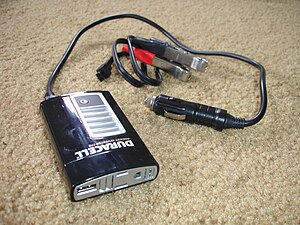
Xantrex 175 watt DC-to-AC power inverter rebadged by Duracell. It has one grounded AC outlet and one USB 5v DC output. It can accept cigarette lighter auxiliary power or battery clips for input. It uses a soft switch for powering on and off. (Photo credit: Wikipedia)
To use an inverter as a source of power for tent camping – decide on the wattage that you will need..
Step 1: Determine what AC appliances you want to operate simultaneously. Add their wattage together and buy an inverter with 20% more capacity. For example, suppose that you want to operate a laptop computer and CPAP machine at the same time. Assuming a few numbers for our example: 75W (laptop typical) + 120W (CPAP machine – your machine will draw a different amount of power) = 195 watts. So, select an inverter of at least 234 watts. For most types of inverters the 20% additional capacity accounts for many manufacturer’s practice of over-reporting the real capacity of their inverter.
Step 2: Determining battery size. Divide watts * number of operating hours by 12 to get amp-hours. Multiply this number by the number of days that you need to operate your devices on battery. Multiply by 2 to determine the number of battery amp-hours required at a minimum.
Step 3: What kind of wire do you use to connect your inverter to the batteries? There are many types of wire, but you’ll want to use either the short wires that come with your inverter, or marine grade wires at least as large as the gauge of the wires that come with your inverters (the smaller the gauge number the larger the wire). I recommend using one gauge larger than the chart to minimize voltage drop. Voltage drop wastes power and causes the inverter to operate outside its ideal design parameters.
Step 4: Connecting it together – Connect the negative lead for the inverter to the negative post of the battery. Connect the positive lead of the inverter to the positive post of the battery. Some inverters have an on/off switch that can be used to turn the inverter completely on or off. If your inverter does not have a switch you will need to either install a switch or be prepared to disconnect a wire to the battery in order to completely turn off the inverter..
Step 5: To charge your battery for use, disconnect the battery from the inverter and attach the charger. The charger will take a variable amount of time charge the battery from house current. By using a smart charger you will fill the battery faster than a simple charger. Look for a charger that says “multistage charger.” You will need the charger with you if your batteries won;t last long enough for the entire camping event.
Step 6: Managing your battery. A 12V battery is fully charged when the resting voltage is 2.7V. To measure resting voltage, charge the battery and let it sit with no connections for at least an hour. Use a voltmeter to check the voltage level. Generally, batteries should be kept above 11.95V at a resting level. The fastest charging will occur between 11.95V and 12.5V. Plan to use your battery within this range when camping. NOTE: start with a fully charged battery at home and recharge (if electricity is available to you when camping). A 125Ah battery discharged to 11.95V will take about 7 hours to replenish the battery to 12.5V
For most weekend uses for small medical devices I’ve found that a single 12V 125Ah battery will suffice for most people using modern CPAP machines. As always, make certain that you know how to determine the power requirements for your specific machine. If you aren’t certain, engage a professional who can help size your system to meet your needs.
Related articles



